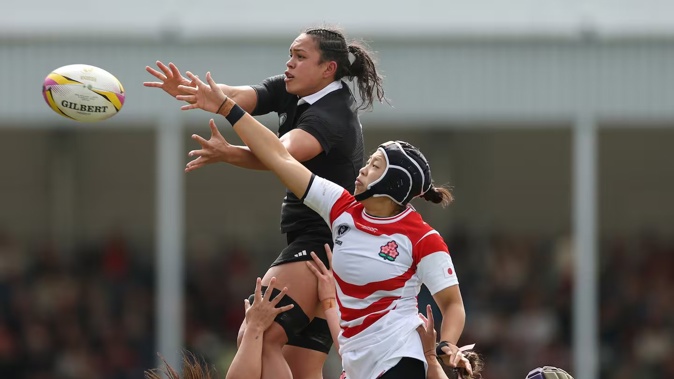
By Adam Julian of LockerRoom
“Wet socks, wet socks,” sang a group of cheerful children undeterred by the bleak Exeter rain as they scampered to Sandy Park, an hour before the Black Ferns faced Japan.
It was a characteristically dreary English day, the kind that prompted those handing out religious pamphlets to smirk while others retreated to the warmth of the pub.
The Turk’s Head would be an excellent choice; this old boozer, located on Exeter High St, dates back to the 1500s and was once a watering hole of Charles Dickens.
Thankfully, there was a reprieve from the inclement weather just before kick-off.
The rising sun of Japan suddenly shone down, shockingly utilising a weapon New Zealand may struggle to counter later against stronger teams: an efficient lineout.
The Black Ferns found themselves clustered together, struggling to move laterally as Japan’s forwards executed a robust drive. Sakurako Hatada was so taken aback that she had a clear path to the corner, she almost butchered it by cutting in too early.
“We knew we could get ’em there,” said Japan’s head coach, Lesley McKenzie, of the Black Ferns’ lineout.
“Mark Bakewell has a heap of experience in the Premiership and France. He’s our forwards coach, recommended by Eddie Jones, and he does a fantastic job. Lineout play isn’t typically a strength for us, but we’ve made real strides.”
Japan won 17 lineouts to NZ’s 10, even managing to pilfer a couple of Black Ferns’ throws.
In the 66th minute, the Black Ferns collapsed a maul from Japan, resulting in a penalty try.
The referee identified replacement lock Laura Bayfield as the guilty party, issuing her a second yellow card and one of the harshest reds in rugby history.
Earlier in the match, Bayfield apparently knocked the ball on deliberately.
In truth, the Black Ferns were never likely to lose to Japan, but Japan, with only 400 registered female rugby players, managed to reduce the deficit by 40 points compared with their previous encounter in 2022.
The physicality of the Black Ferns ultimately proved overwhelming for the Sakura. Japan missed 41 tackles and conceded 331 more post-contact metres, which measure the ground gained after an initial contact.
Much like their performance against Spain last Sunday in York, it took the Black Ferns just over a dozen minutes to break through.
They relied on a familiar combination: Katelyn Vaha’akolo set up Portia Woodman-Wickliffe, who used her signature strength to fend off two defenders while sprinting 40m for her 50th Test try.
Woodman-Wickliffe has become the sixth woman and the first outside of England to score 50 Test tries, and NZ’s top test tryscorer, woman or man.
Portia claims she doesn’t focus much on statistics, so afterwards fullback Braxton Sorensen-McGee was asked about her favourite Woodman-Wickliffe try.
“Ah, all of them,” she laughed. “The way she creates space for everyone, including herself, is awesome.”

Braxton Sorensen-McGee of New Zealand scores her team's seventh try during the Women's Rugby World Cup 2025 Pool C match between New Zealand and Japan at Sandy Park on August 31, 2025 in Exeter, England. Photo / Getty Images
Sorensen-McGee has enchanted the world press with her innate self-confidence. Three tries, the last of which came from well beyond halfway, complemented by four conversions, continued her meteoric rise.
“I get my confidence from the team, my family, and the people around me,” Sorensen-McGee said.
Jorja Miller, with two tries, a team-leading 15 tackles and some out-of-the-ordinary magic, shares a similar sentiment.
While youthful exuberance is unquestionably an asset for NZ, Woodman-Wickliffe was more forthright when addressing some of the Black Ferns’ structural flaws.
“One of our mottos at the last World Cup was no penalties, no lineouts, no mauls, no tries.
“We have to be better at securing our rucks, keeping possession and slowing down opposition ball. Against a real clinical and quality side like England, we’ll get punished.
“That’s not to disrespect Japan. I got smashed a couple of times, and actually, one of my favourite parts of the game was holding up the maul.
“Those parts we don’t get in sevens. I don’t mind getting amongst the nitty-gritty.”

New Zealand flanker Jorja Miller scores her second try during the Women’s Rugby World Cup Pool C match between New Zealand and Japan at Sandy Park in Exeter, England. Photo / Adrian Dennis, AFP
Cowboy Jones player of the tournament?
England’s Meg Jones has emerged as a potential contender for Player of the Tournament.
The Cardiff-born Leicester Tigers centre was named the Premiership Women’s Rugby Player of the Year this year, following a grief-stricken year in which she lost both her parents, Simon and Paula.
“Rugby is my saving grace,” said Jones. “It is such an important part of my life and has definitely helped me through some tough times.”
In the Red Roses’ 92-3 crushing of Samoa, she scored two tries and made two line breaks from just six carries. Although she did not score in the opening round 69-7 defeat of the US, the Telegraph noted her contributions.
“Much of the talk in the lead-up to this game had centred on Jones’ opponent, Ilona Maher, who is rugby’s most-followed player on social media.
However, the American was largely anonymous after a couple of big carries early on, while Jones was involved in much of what was good about England’s performance.”
Jones is also known for doing a cowboy dance after scoring a try. Some spectators have taken to wearing cowboy hats at England games.
Fantastic Freda
Australia’s dramatic 31-31 draw against the US ranks as one of history’s finest Rugby World Cup games. Australia made 229 tackles compared with the US’ 100, yet they led 14-5 and 26-17 before needing a 73rd-minute try from Eva Karpani to secure a share of the honours.
This result has significantly opened up Pool A. Australia currently sits five points ahead of the US, but with five points available for a bonus-point win, the upcoming matches could alter the standings. The US will face Samoa next Saturday, while Australia will take on formidable England. It may all come down to the teams’ respective point differentials. Australia holds an advantage at +73, with the US on -62.
Freda Tafuna produced a performance of the ages for the Eagles against the Wallaroos, scoring three tries, with 17 carries for 46m gained and nine tackles.
Tafuna has a history of performing well against the Black Ferns, too. In the Eagles’ 57-5 loss to NZ in 2024, she became the first American to score tries in consecutive tests against the Black Ferns, having crossed the paint in a 39-17 loss in Ottawa in 2023.
Of Tongan descent, Tafuna helped Lindenwood University in St. Charles, Missouri, win two national championships, which launched her rugby career.
Kristina Sue unavoidably detained, by triumph and weather

Kristina Sue and former teammate Sene Naoupu at work broadcasting during the last World Cup, in Auckland. Photo / Suzanne McFadden
Former Black Ferns halfback Kristina Sue was supposed to assist in the fronting of Sky’s coverage of the Black Ferns against Spain, but after a flight from Palmerston North to Auckland was diverted to Napier due to bad weather, she didn’t make her scheduled appointment.
It was a bittersweet conclusion to a hectic day for Sue, who had helped coach Manukura to their fourth consecutive Hine Ponemona National Top Four title, 20-17, over Hamilton Girls’ High School earlier that morning.
Manukura didn’t lead the contest until the very last salvo. Lock Kingston-Ryze Akuhata-Brown Taiapa, a Ngāti Porou Wahine Toa from Hicks Bay, scored the winning try with a determined wriggle through a furnace of congestion. Her father, Frank Taiapa, played in the legendary 2012 Ngāti Porou East Coast Meads Cup-winning team.
Black Ferns Player of the Year in 2024, Kaipo Olsen-Baker, attended Manukura.
This story was originally published at Newsroom.co.nz and is republished with permission.
Take your Radio, Podcasts and Music with you









